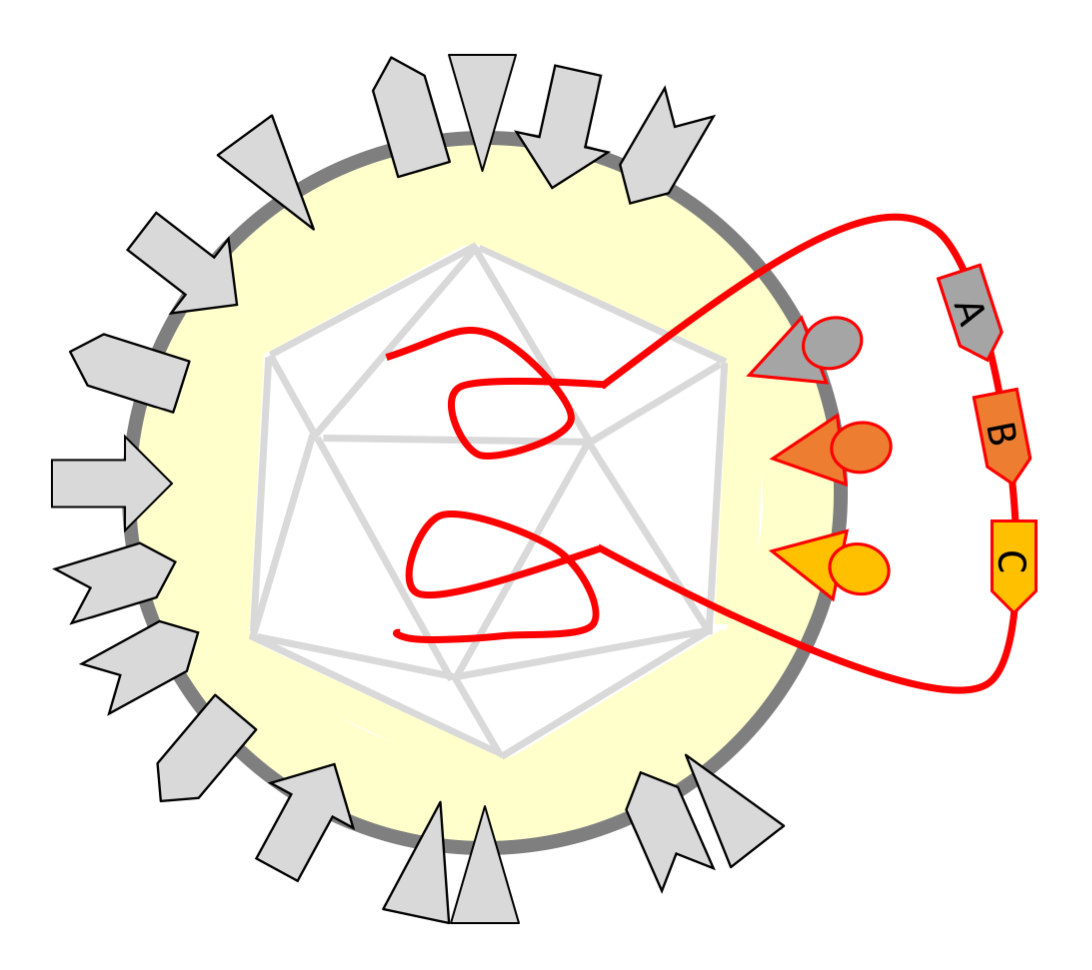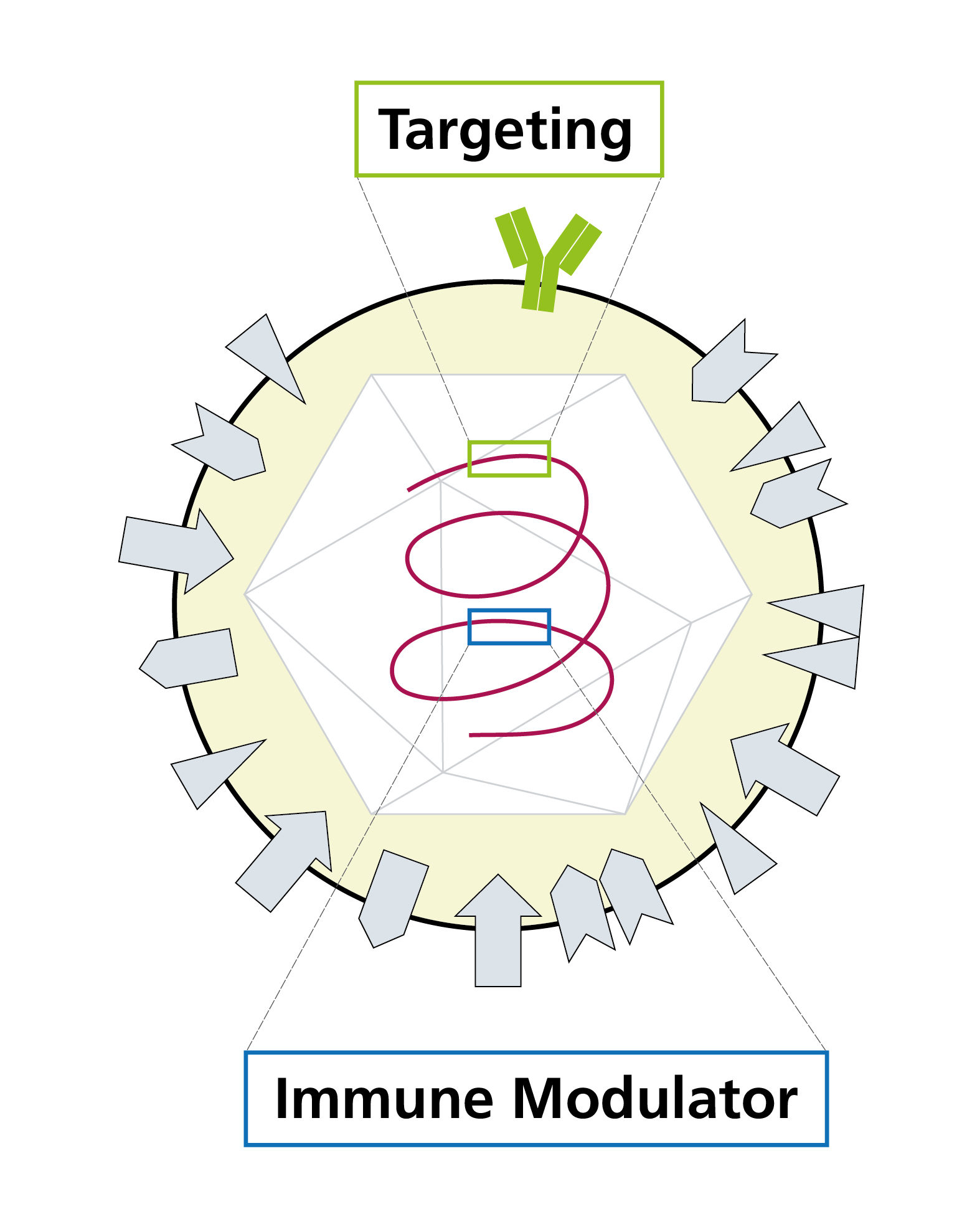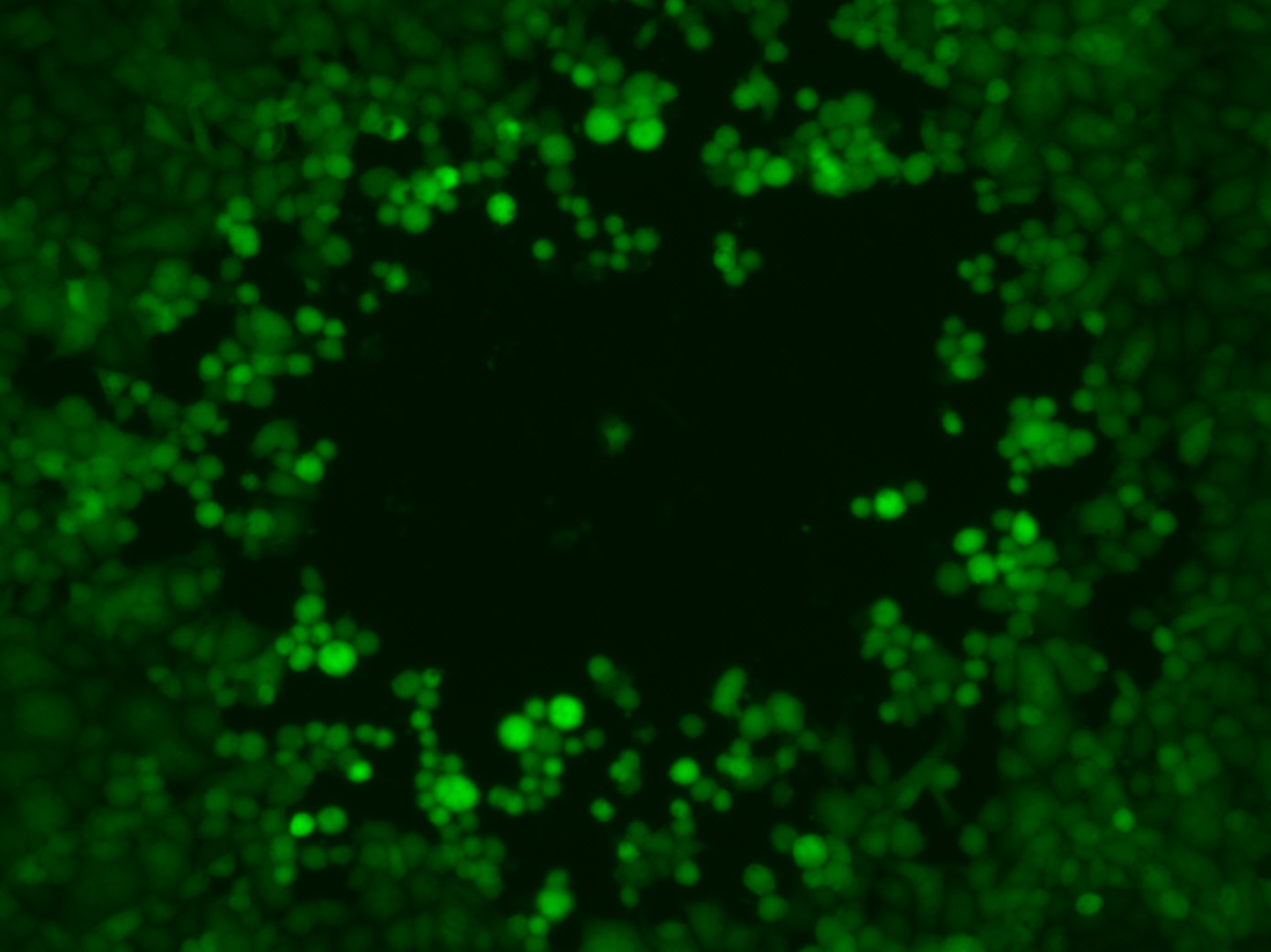Viruses are not just pathogens. The non-cellular particles can also be used as biological tools to fight infections or – so the hope – cancer. Here at Fraunhofer IGB, we are working on this topic.
Therapeutic viruses
Viruses are programmable information carriers and vectors
Viruses are protein capsules, with some of them additionally encased in a lipid membrane. The viral genome enclosed in the protein capsules codes for the virus's blueprint and for its program for replicating viruses. Thus, viruses are information carriers in a very small space.
Viruses depend on cells for their replication. When they infect prokaryotic or eukaryotic cells, they place their viral genome into them. This information transfer is directive and very specific: viruses are equipped with receptors that serve to recognize host cells, dock with them, and finally penetrate them. In this way, information enters the cells and is read there.
Therefore, viruses are excellent biotechnological tools for overcoming cell boundaries and transmitting information.
Table of contents
- Our expertise: Viral genome engineering
- Our technology: Virus engineering platform
- Technologies for the production, analysis and preclinical testing of virotherapeutics in the branch office Virus-based Therapies, Biberach
- Services: Oncolytic viruses
- Services: Vaccine development
- Publications and reference projects
Our expertise: Viral genome engineering
Genome engineering in the laboratory makes it possible to genetically modify the blueprint of viruses in a targeted manner and adapt them for new purposes.
The viruses are reprogrammed in the process: Disease-causing properties can be switched off, functions can be improved or completely new properties can be added. Depending on the type of virus, different amounts of additional information can be stored. Foreign gene elements that endow infected organisms with new functions can also be integrated into the virus genomes in this way.
Viruses as vectors for foreign information
At Fraunhofer IGB, we use genome engineering to establish viruses as vectors for foreign information: For the development of new vaccine platforms and novel drugs (cell and gene therapeutics), for example for virus-based treatment of cancer and tumor vaccination, but also for the treatment of multi-resistant bacteria.
Prof. Bailer's research group has many years of experience in the field of virus engineering – the basis and prerequisite for the customized design of therapeutic viruses. We have been successfully using the Bacterial artificial chromosome (BAC) technology required for this purpose for a long time to modify the viral genome with utmost precision and to produce highly efficient platform vectors.
Biointelligent algorithms as tools
For the engineering of the platform virus, researchers used biointelligent algorithms and corresponding information technologies, which enabled a wide variety of simulations in advance. These tools also allow us, for example, to estimate in advance how many viruses need to be applied to a tumor in order to penetrate it and achieve the desired immune effect. Such calculations are also essential for controlling a biotechnological production of these therapeutic viruses.
Our technology: Novel virus engineering platform against cancer and infections
As part of the Fraunhofer-internal project TheraVision, we have established a novel virus-engineering platform based on the herpes simplex virus (HSV). Since HSV can infect nerve cells, the genes coding for this were specifically switched off. This was possible because herpes viruses have been very well characterized through many years of research and we at Fraunhofer IGB have been able to gain experience with these viruses – especially the engineering of their genome – over many years.
Oncolytic viruses for therapeutic applications
Oncolytic viruses (OV) represent a separate class of gene therapies that are increasingly gaining focus as innovative cancer therapies both as monotherapy or combination therapy. Viruses can be engineered into highly specific drug carriers through genetic modification: The resulting OVs develop their effect on the one hand through specific detection and destruction of tumor cells. In addition, they can recruit and activate tumor-infiltrating immune cells, to include the immune system in fighting the tumor. Thereby, a long-lasting in-situ tumor vaccination can be achieved.

Facilitated integration of transgenes into the platform vector
In the innovation field Virus-based Technologies, a proprietary platform vector based on herpes simplex virus 1 (HSV1) was established as part of the TheraVision project using bacterial artificial chromosome technology. This engineering platform, for which a patent application has been submitted, enables modular programming of the HSV1 genome by facilitating the integration of transgenes. Combined with the possibility of high-capacity engineering, this platform vector is therefore ideally suited as a research tool. Further modifications with the aim of inactivating the neurotoxicity genes of HSV1 resulted in an attenuated vector that significantly reduces viral load in the brain of mice compared to the original vector and thus allows safe application.
Suitability for tumor vaccination demonstrated
As a proof of principle, we have already implemented several transgenes in different combinations into the platform vector. Among others, this made it possible to optimize the targeting of the TheraVision virus to tumor cells. In addition, virus-encoded immune checkpoint inhibitors bind the receptors of the immune system and are consequently functional. Finally, diverse foreign antigens that may contribute to tumor vaccination, could be expressed in a virus-mediated manner.
Platform technology for the facilitated development of tailor-made therapeutic viruses
Overall, the basis for a combined virus immunotherapy was created which enables an effective, safe and sustainable destruction of tumors as well as metastases and at the same time minimizes the risk of systemic side effects. In parallel to virus engineering, a GMP-compliant production process and complex preclinical test systems including human tumor and immune cells have been established by Fraunhofer partner institutes. Thus, a broadly applicable platform technology for the simplified development of tailored therapeutic viruses is available.
Due to its modularity, the new vector platform can be modified for many cancer types and adapted as a vaccine platform.
Contact us if you are interested!
Technologies for the production, analysis and preclinical testing of virotherapeutics in the branch office Virus-based Therapies, Biberach
Despite their obvious potential as efficient therapeutic modality, currently only eight virus-based therapies have been approved by the responsible regulatory agency in America, the FDA and its European counterpart, the EMA. While this lack in clinically approved oncolytic viruses partly originates from their more complex structure and mode of action compared to conventional cancer therapeutics it also illustrates that further biotechnological research spanning the entire pharmaceutical value chain from early to late stage development is required to path the successful transition of (oncolytic) viro-science into the clinic.
New branch office Virus-based Therapies (VBT) for the production of complex virotherapeutics
This is precisely where the state of Baden-Württemberg's funding to establish a novel Fraunhofer IGB branch in Biberach an der Riß comes in, as this newly founded research unit focuses on the biotechnological development of virus-based therapeutics with a focus on virus, cell, and process technologies. The set-up and launch of the novel facility in Biberach was significantly supported by the expertise and existing infrastructures at the Fraunhofer IGB headquarter in Stuttgart.
From virus engineering to analyzing the formulated virus: Fraunhofer IGB provides expertise along the entire drug development process
Our competencies established at both the Stuttgart and Biberach VBT branch span the entire pharmaceutical development process starting with molecular virus engineering to increase activity and efficiency and ranging to process developments to improve virus production and novel methods to analyze the formulated virus. Consequentially, we will contribute to establish oncolytic viruses and bacteriophages as accepted and broader-used therapeutic modalities.
Our services
Oncolytic viruses

The ability of viruses to kill cancer cells has long been known, but the therapeutic potential of viruses has only come into focus in the last decade. Initial results from preclinical and clinical studies with therapeutic viruses are promising. In 2015, an oncolytic virus based on herpes simplex virus 1 (HSV1), called Imlygic®, for the treatment of malignant melanoma became the first oncolytic virus therapeutic to receive approval from the Food and Drug Administration (FDA), and was subsequently approved by the European Medicines Agency (EMA). This breakthrough is stimulating the development of new viral therapeutics.
Tumor vaccination: Oncolytic viruses activate the immune system
At Fraunhofer IGB, we have been developing biointelligently modified viruses for years for so-called tumor vaccination. Our specialty is oncolytic viruses that fight cancer cells. These are seen as a beacon of hope in cancer therapy, as they on the one hand, destroy malignant cells in a targeted manner and on the other hand, activate the patient's immune system at the same time.
For this tumor vaccination, we have modified herpes simplex viruses and provided them with information in such a way that they target cancer cells, the corresponding instructions are carried out there and the cancer cells are subsequently destroyed. But not only that: the body's own surrounding immune cells, activated at the site of the tumor, also have the potential to spread throughout the body in a unique systemic effect to fight metastases. The immune system is thus stimulated to deliver a powerful, endogenous therapy.
If you are interested in the further development of our patented technology, please contact us!
Vaccine development

Vaccines provide preventive protection against infections caused by bacterial or viral pathogens. The vaccines are recognized by the body as foreign and stimulate the body's own defense system to immunize without the outbreak of the respective disease. The body of the vaccinated person reacts with the production of specific antibodies (humoral cell response) and, at best with a robust T-cell response - another important building block of the body's defenses, which can then quickly fight off an infection with "real" viruses.
At Fraunhofer IGB, we are working on various approaches to optimize or develop vaccines:
- In collaboration with other Fraunhofer institutes, for example, we have developed a new, purely physical method for inactivating dead vaccines that does not require toxic chemicals.
- In another approach, we use our virus engineering platform established on the basis of an attenuated herpes virus as a vector for vaccines.
- Finally, we have designed virus-like particles that are also suitable as carriers for vaccine antigens or their nucleic acids.
New inactivation method for dead vaccines
Inactivated vaccines, so-called dead vaccines, consist of pathogens that are usually inactivated via toxic chemicals such as formaldehyde. The inactivation process is lengthy, and the chemicals must be removed from the preparation after use. In addition, chemical inactivation often destroys important proteins of the pathogens, so that the vaccine loses effectiveness.
In the Fraunhofer ELVIRA project, the four Fraunhofer Institutes IZI, IGB, FEP and IPA succeeded in establishing a physical technology that overcomes these disadvantages. This enables viruses, bacteria or parasites to be inactivated with low-energy electron beams within seconds – instead of several days or even weeks – and without the addition of toxic substances such as formaldehyde. Antigens important for the vaccination effect have been shown to remain in the irradiated organisms, while their genome, and thus their infectivity, is reliably destroyed by the electrons.
In a follow-up project, eVaccine, funded by the Bill and Melinda Gates Foundation, researchers have developed two corresponding prototypes for the automatic inactivation of polio pathogens.
Are you interested in using the electron beam process to inactivate your vaccines? We would be happy to talk to you!
Virus engineering platform for vaccines
For rapid availability of vaccines against emerging pathogens, the use of platform technologies for simplified adaptation of vaccines to new pathogens or even genetic variants of new pathogens is essential.
At Fraunhofer IGB, we have developed an engineering platform based on an attenuated herpes simplex virus that can be used not only for therapeutic (oncolytic viruses, see above) but also for preventive purposes (vaccines).
By incorporating an appropriate vaccine antigen into the viral platform, carrier viruses can be produced as potential vaccines. The modular viral system can be rapidly adapted to emerging or mutated pathogens, if required, and as a combination vaccine, thus also supporting the management of pandemics.
CoroVacc
We have also chosen this platform at Fraunhofer IGB in the anti-corona project CoroVacc to develop a corona vaccine. In cooperation with the Fraunhofer Institute for Cell Therapy and Immunology IZI in Leipzig, we are researching an attenuated SARS-CoV-2-specific vaccine virus derived from a herpes virus in order to activate the immune system of the vaccinated person and thus provide lasting protection.
If you are interested in the further development of our patented technology for your vaccine, please contact us!
Virus-like particles for vaccination
Another new approach for the production of vaccines is virus-like particles. These biobased capsules mimic viruses and are suitable for packaging and targeting active ingredients (drug delivery). They can also serve as an excellent basis for vaccines, for example against viruses that are difficult or impossible to grow in vitro, or against foreign proteins that are presented on the surface.
Further information on virus-like particles can be found here.
Selected publications
Bailer, S. M.; Funk, C.; Riedl, A.; Ruzsics, Z. (2017)
Herpesviral vectors and their application in oncolytic therapy, vaccination, and gene transfer
Virus Genes 53 (5): 741-748. doi: 10.1007/s11262-017-1482-7.
Striebinger, H., Funk, C., Raschbichler, V., Bailer, S. M. (2016)
Subcellular trafficking and functional relationship of the HSV-1 glycoproteins N and M
Viruses 8 (3): 83. doi: 10.3390/v8030083.
Funk, C.; Ott, M.; Raschbichler, V.; Nagel, C. H.; Binz, A.; Sodeik, B.; Bauerfeind, R.; Bailer, S. M. (2015)
The herpes simplex virus protein pUL31 escorts nucleocapsids to sites of nuclear egress, a process coordinated by its N-terminal domain
PLoS Pathog. 11 (6): e1004957. doi: 10.1371/journal.ppat.1004957.
 Fraunhofer Institute for Interfacial Engineering and Biotechnology IGB
Fraunhofer Institute for Interfacial Engineering and Biotechnology IGB